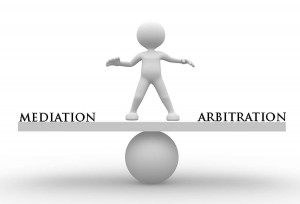 [Deze pagina is voorlopig enkel in het Engels beschikbaar.]
[Deze pagina is voorlopig enkel in het Engels beschikbaar.]
The choice: arbitration vs. mediation. You’re not sure which of two common dispute resolution processes, mediation or arbitration, to use to resolve your conflict. Mediation is appealing because it would allow you to reach a collaborative settlement, but you’re worried it could end in impasse. You know that arbitration would wrap up your dispute resolution conclusively, but it wouldn’t give you much say in the outcome. But what if you could get the best of both worlds by using med-arb to help with dispute resolution? That is when med-arb can help.
Mediation-arbitration is an alternative dispute resolution process that uses mediation and arbitration in order to resolve legal issues without going to court. It is often referred to as "med-arb".
Mediation-arbitration is voluntary. This means that the parties need to agree to use this process. No one can be forced take part, or forced to agree on the issues at hand. But, if the parties do not agree on the issues, the arbitrator decides.
First stage
First, the parties meet with a mediator. A mediator is a person trained to help the parties agree on their issues without taking sides. They help the parties during negotiations to try and reach an agreement.
Mediators do not make decisions and do not force the parties to agree. They help the parties speak with each other and understand each other's situation. Their goal is to help both parties compromise and agree on things.
Second stage
If the parties cannot agree with the mediator's help, the process continues with an arbitrator (who can, for the sake of efficiency, be the same person as the mediator, as long as the parties do not object to that).
Mediation-arbitration is a hybrid dispute resolution mechanism which combines the benefits of mediation and arbitration.
If the mediation ends in impasse, or if issues remain unresolved, the parties can then move on to arbitration. The mediator can assume the role of arbitrator and render a binding decision quickly, or an arbitrator can take over the case after consulting with the mediator.
In med-arb, parties first attempt to hammer out a collaborative agreement, working together and in private sessions with a mediator or « med-arbiter », a neutral third party trained in med-arb.
In many cases, the med-arb process turns into a successful mediation with no need for arbitration. Given the nature of the process, it is in the parties’ best interest to reach a settlement during the mediation stage of the process. Should they fail to reach an agreement, the arbitrator shall decide the matter in a binding fashion (i.e. the parties lose control over the outcome in that scenario).
If a « med-arbiter » is handling the entire process, he would impose a binding decision based on his assessment about the case. If parties had reached an agreement on some issues, the « med-arbiter » would rule only on the issues that remained. Alternatively, as mentioned, an arbitrator could take over all or part of the dispute from a mediator (especially if one of the parties objects to the mediator and arbitrator being the same person).
What it can do: the threat of having a third party render a decision in a binding arbitration often inspires disputants to work extra hard in mediation to come to an agreement. Med-arb can be especially effective when parties are under time pressure, and when they need to work with the other party in the future. If parties hire one person as mediator and arbitrator, they save time and money by eliminating the need to start arbitration from square one if mediation fails.
Klik hier voor meer informatie over hybride mechanismen van buitengerechtelijke geschillenoplossing.
